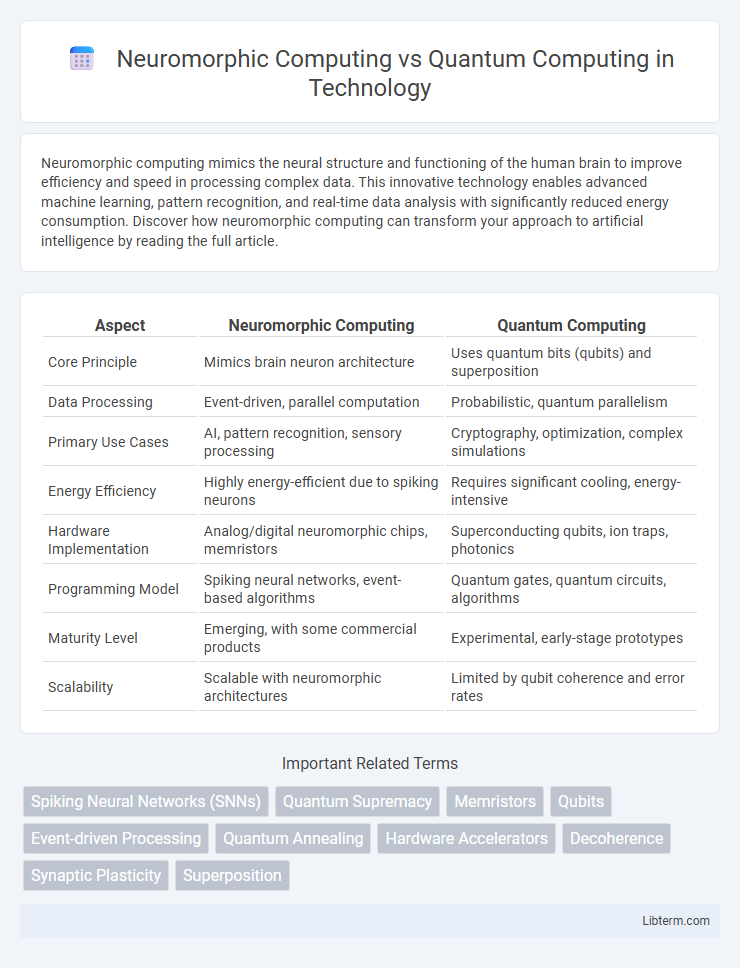Neuromorphic computing mimics the neural structure and functioning of the human brain to improve efficiency and speed in processing complex data. This innovative technology enables advanced machine learning, pattern recognition, and real-time data analysis with significantly reduced energy consumption. Discover how neuromorphic computing can transform your approach to artificial intelligence by reading the full article.
Table of Comparison
| Aspect | Neuromorphic Computing | Quantum Computing |
|---|---|---|
| Core Principle | Mimics brain neuron architecture | Uses quantum bits (qubits) and superposition |
| Data Processing | Event-driven, parallel computation | Probabilistic, quantum parallelism |
| Primary Use Cases | AI, pattern recognition, sensory processing | Cryptography, optimization, complex simulations |
| Energy Efficiency | Highly energy-efficient due to spiking neurons | Requires significant cooling, energy-intensive |
| Hardware Implementation | Analog/digital neuromorphic chips, memristors | Superconducting qubits, ion traps, photonics |
| Programming Model | Spiking neural networks, event-based algorithms | Quantum gates, quantum circuits, algorithms |
| Maturity Level | Emerging, with some commercial products | Experimental, early-stage prototypes |
| Scalability | Scalable with neuromorphic architectures | Limited by qubit coherence and error rates |
Introduction to Neuromorphic and Quantum Computing
Neuromorphic computing emulates the neural structure and functioning of the human brain using spiking neural networks, enabling energy-efficient processing for tasks like pattern recognition and sensory data interpretation. Quantum computing leverages quantum bits (qubits) that exist in superposition and entanglement states to perform complex computations exponentially faster than classical computers, particularly in factoring large numbers and simulating quantum systems. Both paradigms represent revolutionary approaches to computing architecture, with neuromorphic focusing on brain-inspired models and quantum exploiting quantum mechanics principles.
Fundamental Principles of Neuromorphic Computing
Neuromorphic computing mimics the neural structure and functioning of the human brain by utilizing spiking neural networks and event-driven processing to achieve high efficiency and low power consumption. Unlike traditional von Neumann architectures, neuromorphic systems rely on parallel, distributed processing with adaptive synapses that facilitate learning and memory. This approach fundamentally contrasts with quantum computing, which leverages quantum bits and superposition for immense computational power but does not replicate biological neural mechanisms.
Core Concepts of Quantum Computing
Quantum computing leverages principles of quantum mechanics, such as superposition and entanglement, to perform complex calculations exponentially faster than classical systems. Qubits, the fundamental units of quantum information, enable simultaneous representation of multiple states, enhancing computational power for specific problems like cryptography and optimization. Neuromorphic computing, inspired by neural structures, differs by emphasizing brain-like architectures for efficient pattern recognition and learning, rather than exploiting quantum phenomena.
Neuromorphic Architectures and Designs
Neuromorphic computing architectures mimic the brain's neural structure, utilizing spiking neural networks and event-driven processing to achieve energy-efficient computation. These designs emphasize hardware implementations such as memristors and silicon neurons that enable parallel, low-power learning and adaptation. Unlike the probabilistic nature of quantum computing, neuromorphic systems excel in pattern recognition, sensory processing, and real-time decision making through biologically inspired circuits.
Quantum Hardware and Qubit Technology
Quantum hardware leverages qubits, which exploit superposition and entanglement to perform complex computations beyond classical limits. Technologies such as superconducting qubits, trapped ions, and topological qubits drive scalability and error correction advancements in quantum computing. In contrast, neuromorphic computing builds hardware inspired by neural architectures, prioritizing parallel processing and energy efficiency rather than quantum coherence principles.
Processing Speed and Computational Efficiency
Neuromorphic computing excels in processing speed by mimicking neural architectures, enabling real-time data processing with low energy consumption. Quantum computing leverages qubits and superposition, achieving exponentially faster computational efficiency for specific complex problems like factorization and optimization. While neuromorphic systems optimize parallel processing and energy efficiency, quantum computers provide speed advantages in probabilistic and quantum simulation tasks.
Energy Consumption and Sustainability Comparison
Neuromorphic computing mimics the brain's neural architecture, offering ultra-low energy consumption by enabling event-driven processing and sparsity, making it highly efficient for tasks like pattern recognition. Quantum computing requires significant cooling infrastructure and complex qubit error correction, resulting in substantial energy demands that presently limit its sustainability. Comparing both, neuromorphic systems provide a more practical, energy-efficient solution for sustainable computing in edge applications, while quantum computing's energy challenges remain a critical barrier for large-scale, sustainable deployment.
Application Areas: Neuromorphic vs Quantum Solutions
Neuromorphic computing excels in real-time sensory data processing, robotics, and edge AI applications by mimicking neural network architectures to enhance energy efficiency and adaptability. Quantum computing offers unparalleled advantages in cryptography, complex molecular simulations, and optimization problems by leveraging quantum superposition and entanglement for massive parallelism. Industries such as pharmaceuticals, finance, and logistics increasingly utilize quantum solutions for problem-solving at scales impossible for classical and neuromorphic systems.
Current Challenges and Limitations
Neuromorphic computing faces significant challenges in scalability, energy efficiency under complex workloads, and the development of standardized programming models for large-scale neural networks. Quantum computing struggles with qubit coherence, error rates, and the requirement for extreme operating conditions like near absolute zero temperatures, limiting practical, widespread applications. Both paradigms require breakthroughs in hardware design and software algorithms to overcome current technical and operational limitations.
Future Prospects and Integration Possibilities
Neuromorphic computing, inspired by the human brain's neural architecture, excels in energy-efficient pattern recognition and adaptive learning, while quantum computing promises exponential speed-ups in solving complex optimization and cryptographic problems through qubits and superposition. Future prospects highlight potential hybrid systems where neuromorphic processors handle sensory data preprocessing and learning tasks, complementing quantum computers' capability in large-scale problem-solving, fostering breakthroughs in AI and material sciences. Integration possibilities involve developing efficient interfaces and algorithms to leverage neuromorphic networks for error mitigation and quantum data encoding, pushing the frontier of computational intelligence and scalable quantum advantage.
Neuromorphic Computing Infographic

 libterm.com
libterm.com